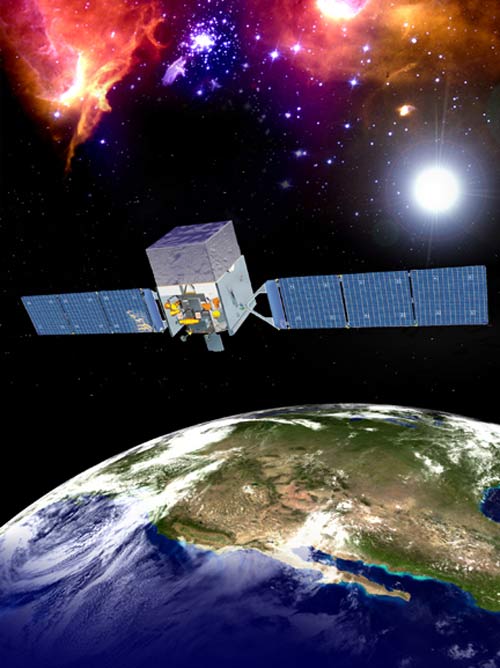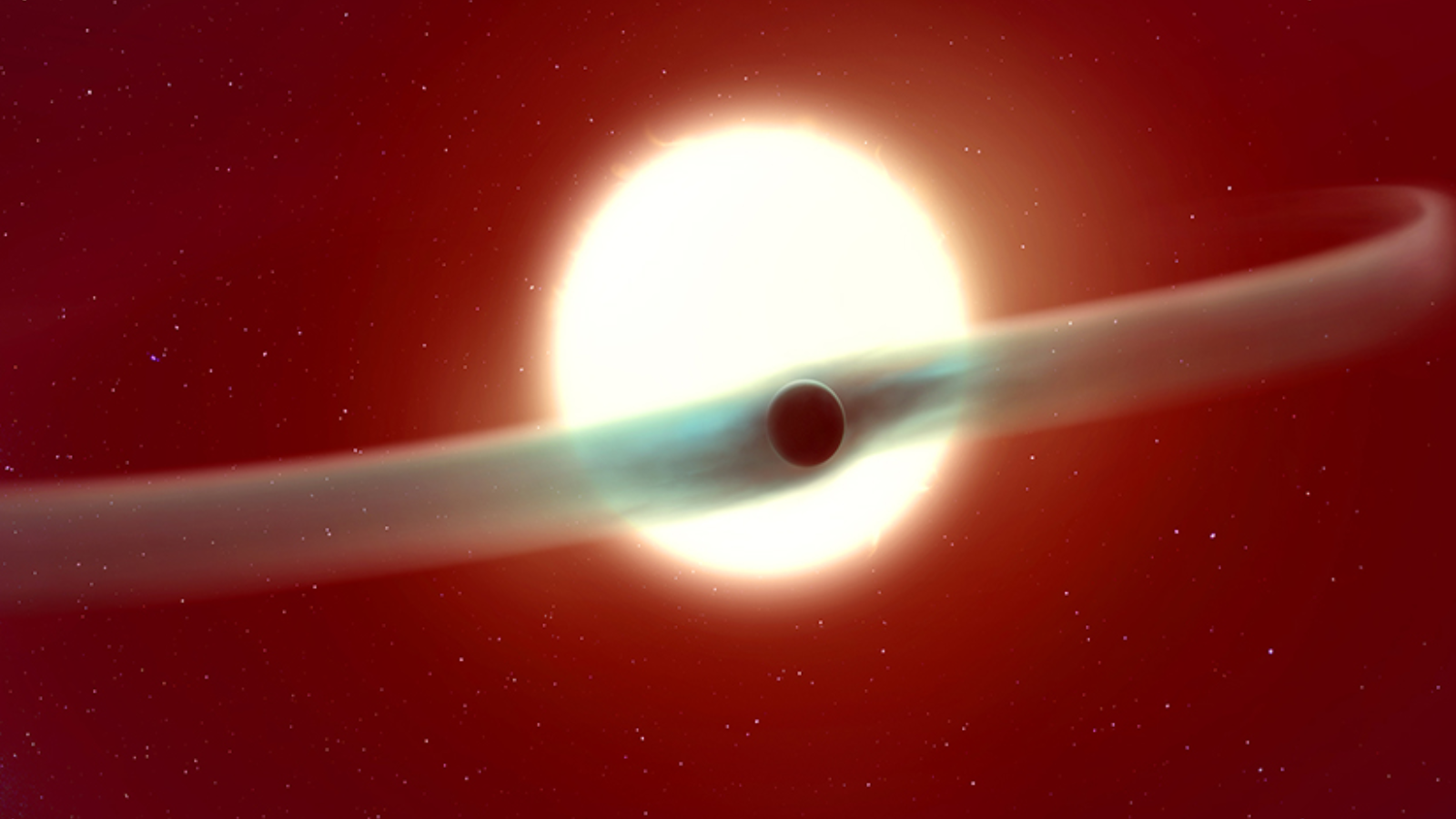New Space Telescope to Explore the Unknown

By scanning the universe for the most powerful form of radiationknown, the Gamma-Ray LargeArea Space Telescope (GLAST) could shed light on dark matter, microscopic blackholes and other cosmic enigmas.
Infact its greatest promise is that it might discover something nobody is evenlooking for.
Gamma rays are thehighest energy form oflight, created under some of the mostviolent events in the universe, such as the deathof stars or the annihilation of matter. GLAST is the first gamma-ray observatory to survey theentire sky every day with unprecedented sensitivity, and the hope isthat it will open a dramatic new window onto the cosmos. This multi-agency,multi-national effort is working toward a launch on June 7.
"If you couldsee the sky with gamma-ray eyes, it would look entirely different from thenight sky now," said Steve Ritz, the GLASTproject scientist and an astrophysicist at NASA's Goddard Space Flight Centerin Greenbelt, Md. "Gamma rays are emitted in the most extreme environmentsin the universe, where the gravitational and electric and magnetic fields areso much higher than anything you could ever study directly on Earth.
Forexample, GLAST could help find darkmatter, the as yet unseen substance that could make up 90 percent of allmatter in the universe, whose presence scientists infer by its effects on themotion of galaxies. In theory, dark matter particles are their ownantiparticles, meaning they destroy each other when they come into contact.
Theannihilation of dark matter would result in gamma rays with energies specificto the masses of the obliterated particles, "a signature that would beunmistakable," Ritz said. "There are a lotof mysteries about what dark matter is, how densely it is distributed, andwhere in the galaxy it clumps that GLAST could help answer."
Tiny black holes
Breaking space news, the latest updates on rocket launches, skywatching events and more!
GLAST may also detect microscopicblack holes that may have formed right after the Big Bang. No one is sureif any exist, but if they did and have survived until now, they could besmaller than a proton but have the mass of Mt. Everest. All black holestheoretically evaporate at least some of their mass away as energy, andmicroscopic black holes could in theory vanish completely in an explosion ofsundry particles and gamma rays that GLAST could detect.
"If these microscopic blackholes exist and they evaporated, there would be this rising pulse of gamma raysthat would then go to zero, and that's never been seen before, so that would bea very distinct signal," said Chip Meegan, GLAST Burst Monitor principalinvestigator and an astrophysicist at NASA's Marshall Space Flight Center, inHuntsville, Ala.
Atleast once a day, the universe is rocked by the mightiest explosions known —blasts of incredibly powerful gamma rays. The engine that powers these gammaray bursts is unknown, but they seem to emerge during the birthsof black holes, or during the mergers of neutron stars with black holes orother neutron stars.
"Wedon't really understand the physics involved because it's so complicated, sinceyou're releasing a lot of energy in such a short time — they can each release as much energy in a few seconds as thesun does in its entire 10 billion year lifetime," Meegan said."Hopefully we'll be able to study whole new aspects of gamma ray burststhat we didn't before."
The super-massive black holes at the center of galaxies — whichhave as much as billions of times the mass of our sun — also generateincredible amounts of gamma rays. As they rip stars apart, they spew out jetsof hot gas moving near the speed of light that emit gamma rays. By analyzingthis radiation, GLAST could help solve the mystery of how these jets are made,and therefore yield insights on how black holes affect the space around them.
"We want to understand how these super-massive black holeswork, how they got there, and how they can accomplish feats of suchpower," Ritz said. "We're really just beginning to understandthem."
Light's speed
GLAST could also help see if the speedof light really is constant regardless of wavelength. According toEinstein's theory of relativity, all light travels at the same speed, but somerecent theories suggest that extremely high-energy, short-wavelength gamma raysmight experience a turbulence of sorts in space-time from virtual matterrepeatedly forming and disappearing. As such, their speed might vary slightlyover the course of billions of light years, making them arrive just before orafter lower-energy rays from the same gamma ray burst.
"If this effect exists, it's not something that you couldreally see on Earth," Ritz said. "You'd essentially want to see howlight does on a long-distance race, and that's billions of light years. Butgamma ray bursts are so bright that you could see them from such vastdistances. GLAST could really see these time differences."
Perhaps most exciting is thepossibility that GLAST will find something no oneis expecting. This space telescope can peer a range of high-energy gammarays that is virtually unexplored.
"There's such a leap forwardin capabilities with GLAST that we have a really good chance of discoveringthings not even on the list yet," Ritz said.
This space observatory's Large Area Telescope can see a fifth ofthe sky at any given moment with unparalleled sensitivity for gamma rays. Toimprove it further, theGLAST Burst Monitor constantly sees in all directions at once to watch forsudden flares of gamma rays produced by gamma ray bursts and solar flares. GLAST will circle some 340 miles above the Earth toview gamma rays unimpeded by the atmosphere, completing an orbit every 95minutes and viewing the entire sky every two orbits.
GLASTwill receive a new name once in orbit, chosen fromsome 12,000 suggestions given by the general public around the world. The spacetelescope's first basic results might come out as soon as three monthsafterward.
The mission is scheduled for liftoff atop a Delta 2 rocket at 11:45 a.m. EDT on June 7. The mission has been delayed twice because of technical issues with the booster.
- The Strangest Things in Space
- The Enduring Mysteries of Light
- Top 10 Star Mysteries

Charles Q. Choi is a contributing writer for Space.com and Live Science. He covers all things human origins and astronomy as well as physics, animals and general science topics. Charles has a Master of Arts degree from the University of Missouri-Columbia, School of Journalism and a Bachelor of Arts degree from the University of South Florida. Charles has visited every continent on Earth, drinking rancid yak butter tea in Lhasa, snorkeling with sea lions in the Galapagos and even climbing an iceberg in Antarctica. Visit him at http://www.sciwriter.us
